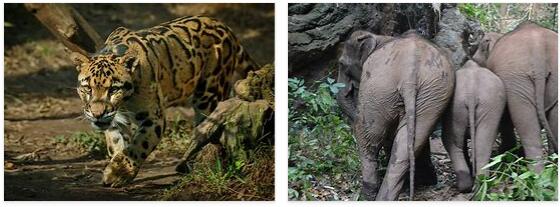Animals and Plants
Where did the woods go?
In the middle of the last century, more than half of Thailand’s land area was still forest. These stocks have declined sharply, to only 20 percent in a few decades, and they continue to decline. These areas were cleared and often also settled in order to create more space for people or simply to sell the wood.
Rainforest and mangroves
Since the temperatures in the north and south of the country are very different, the flora also differs. In the south you will find dense rainforests. It is usually warm or even hot here. The humidity is high. The conditions for a dense rainforest are therefore ideal. Trees reach a height of up to 70 meters here.
Mangrove forests grow in the far south and find their home in a salty soil. Unfortunately, these trees, which are so important for the ecological balance, are cut down again and again and then no longer offer any protection against the tidal waves that can occur in this region. The sea or the waves then reach the shore unhindered and wash everything away.
Important woods
In the north of the country, a change in the seasons is more noticeable than in the south. From December onwards it is often dry, but also cooler. The deciduous trees in the region then lose their leaves. At the beginning of the rainy season in May, the trees wear their leaves again.
The teak tree will continue to operate because of its hard wood to furniture and therefore often beaten. Large bamboo forests also grow in northern Thailand. The rubber tree is of economic importance. This is because rubber can be extracted from this. A large part of the world’s rubber production comes from Thailand.
Which animals live in Thailand?
Many animal species find a home in the dense rainforest of Thailand. But many animals are now threatened with extinction, such as the tiger, the leopard or the rhinoceros. A very peculiar animal is the tapir, which looks so funny. While it may look like a pig or anteater, it is related to horses and rhinos. More about the Tapir you learn on animals world.
Mammals
Although some animal species are threatened with extinction, there are still more than 300 species of mammals in Thailand. These include the some species of monkeys that are native to Thailand, such as the gibbons and macaques. Lynx, ocelots and panthers, which were hunted for their fur for a long time, still have a home in Thailand. And the Asian elephants, which differ from the African elephants because of their smaller ears, live, for example, in the border region with Myanmar.
Reptiles and fish
Many reptiles also find optimal conditions in Thailand. They include 100 species of snakes. Crocodiles romp in the rivers of Thailand, which can also be dangerous to humans.
Thailand is also home to the world’s largest fish, the whale shark. It is actually a fish and it can be up to twelve meters long. Incidentally, it is very peaceful and only eats plankton, so it is a vegetarian. The whale shark is also on the list of endangered species. You can learn more at animals world.
Pretty dangerous!
While the shark is not dangerous to humans, the poisonous snakes in Thailand can. There are 16 poisonous species and some of them can be fatally bitten. The king cobra in particular is dangerous along with certain species of viper.
The centipede should also be avoided. Its poison is rarely fatal, but the effect is quite unpleasant and it hurts. It is worse for children to be bitten by a centipede than for an adult.
Animal beautiful
According to ebizdir, a total of 7000 species of insects live in Thailand. Among them are 500 species of butterflies, whose colors and shapes inspire the viewer. 1000 species of birds also live in Thailand. Many have found refuge in special bird sanctuaries.
Economy
Made in Thailand
As early as 2011, the World Bank referred to Thailand as an “upper middle-income country”. One speaks of the country’s success story in economic terms. Thailand is developing further and further away from a country that primarily relies on agriculture.
Agriculture contributes only ten percent to GDP, industry 40 percent and services 50 percent. In terms of industry, the automotive industry is particularly important, the electronics industry and also the textile industry. Made in Thailand can now be found on many clothing labels.
Many work in agriculture
Although the country does not make a lot of money from agriculture, 40 out of 100 people work in the fields. Rice and rubber are grown here, for example. But also corn, sugar cane and cotton as well as various fruits are among the most important agricultural products of Thailand.
Trade with Germany
Germany supplies products from the chemical, electronic and automobile sectors to Thailand. Thailand delivers electronics, rubber, food and jewelry to Germany.
The tourism industry
Tourism is a growing industry. After a bad tsunami swept across the coasts of Thailand in 2004, killing many people, tourism stalled for a time and the number of tourists declined. That has changed in the meantime and more tourists are coming to the country again.
Export and import
Thailand exports half of what is produced and grown. This is also called export. Most buyers are in Asia, but the European Union and the USA also buy many goods from Thailand.
But Thailand also has to import goods – especially energy such as oil. The valuable oil comes to a large extent from the Middle East. The ASEAN states and Japan are also countries from which Thailand purchases a great deal of goods. The countries of Europe and America do not make up that large part of the imported goods.








